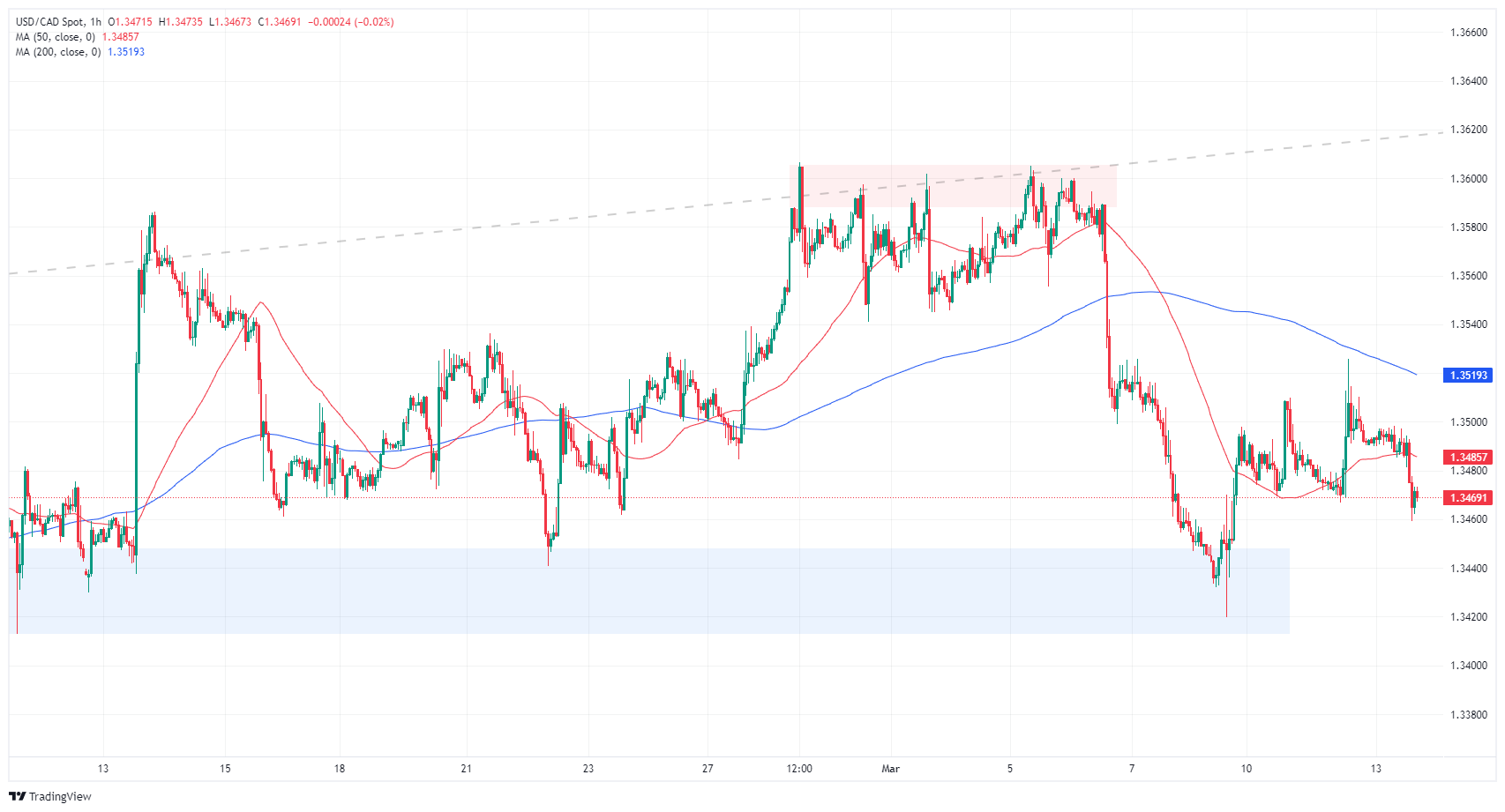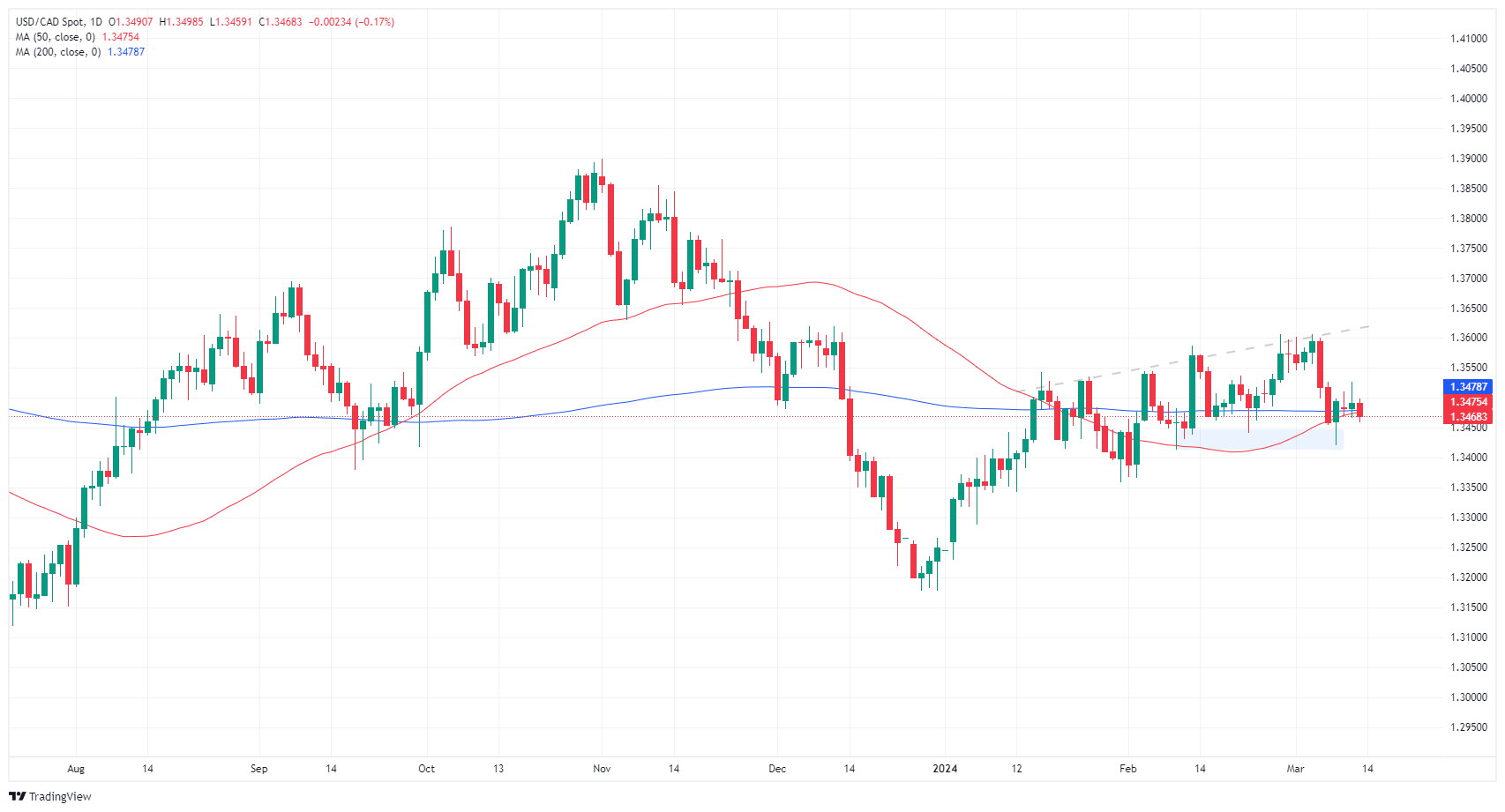- Analytics
- News and Tools
- Market News
- Canadian Dollar recovers ground on Wednesday, markets await US PPE and Retail Sales
Canadian Dollar recovers ground on Wednesday, markets await US PPE and Retail Sales
- Canadian Dollar pulls back to even against US Dollar midweek.
- Canada brings little data of note to the table.
- US PPE, Retail Sales on offer for Thursday.
The Canadian Dollar (CAD) found some room on the upside at the midweek inflection point as investors await Thursday’s US Producer Price Index (PPI) and Retail Sales figures. The CAD continues to wrestle with the US Dollar (USD), but the Canadian Dollar is on pace to be one of the strongest performers this week as the only major currency entirely in the green.
Go figure! Canada’s high-performance week comes when there’s no meaningful Canadian data on offer. Canadian Manufacturing Sales for January, slated for Thursday, are expected to recover to 0.4% from the previous -0.7%. Canadian Housing Starts come on Friday, expected to tick up slightly to 230K from 223.6K. Neither print is expected to draw much attention, if any.
After Thursday’s US PPE and Retail Sales, Friday will wrap things up with another round of University of Michigan Consumer Sentiment and Expectation prints for March. UoM Consumer Sentiment is forecast to hold steady at 76.9, while UoM Consumer Inflation Expectations last showed US consumers expected annual inflation to land somewhere around 2.9%.
Canadian Dollar price this week
The table below shows the percentage change of Canadian Dollar (CAD) against listed major currencies this week. Canadian Dollar was the strongest against the Japanese Yen.
| USD | EUR | GBP | CAD | AUD | JPY | NZD | CHF | |
| USD | -0.03% | 0.44% | -0.12% | 0.00% | 0.65% | 0.30% | 0.01% | |
| EUR | 0.02% | 0.46% | -0.11% | 0.02% | 0.67% | 0.33% | 0.04% | |
| GBP | -0.44% | -0.46% | -0.57% | -0.45% | 0.22% | -0.13% | -0.42% | |
| CAD | 0.13% | 0.10% | 0.55% | 0.12% | 0.75% | 0.42% | 0.14% | |
| AUD | 0.01% | -0.01% | 0.42% | -0.14% | 0.66% | 0.34% | 0.01% | |
| JPY | -0.65% | -0.68% | 0.04% | -0.77% | -0.68% | -0.32% | -0.64% | |
| NZD | -0.30% | -0.33% | 0.13% | -0.44% | -0.31% | 0.34% | -0.29% | |
| CHF | -0.05% | -0.04% | 0.41% | -0.14% | -0.04% | 0.62% | 0.28% |
The heat map shows percentage changes of major currencies against each other. The base currency is picked from the left column, while the quote currency is picked from the top row. For example, if you pick the Euro from the left column and move along the horizontal line to the Japanese Yen, the percentage change displayed in the box will represent EUR (base)/JPY (quote).
Technical analysis: USD/CAD stuck into week’s lows as Canadian Dollar fights back
The Canadian Dollar (CAD) is moderately higher on Wednesday, finding gains against the majority of its major currency peers. The CAD is in the red against the Australian Dollar (AUD) in the midweek trading session, but within a scant tenth of a percent of the day’s opening bids. Meanwhile, the CAD has gained nearly a quarter of a percent against the Japanese Yen (JPY) and is up around a sixth of a percent against both the US Dollar and the Pound Sterling (GBP).
USD/CAD slipped back into the week’s low bids as the Canadian Dollar found firmer footing, setting a new low for the week near 1.3460. The pair is still on the high side of last week’s swoon into 1.3420, and near-term price action has a technical ceiling priced in at the 200-hour Simple Moving Average (SMA) near 1.3520.
Daily candles continue to get hung up on the pair’s 200-day SMA at 1.3478, and directional momentum remains limited despite a recent pattern of higher highs. A supply zone is priced in just above the 1.3400 handle.
USD/CAD hourly chart
USD/CAD daily chart
Canadian Dollar FAQs
The key factors driving the Canadian Dollar (CAD) are the level of interest rates set by the Bank of Canada (BoC), the price of Oil, Canada’s largest export, the health of its economy, inflation and the Trade Balance, which is the difference between the value of Canada’s exports versus its imports. Other factors include market sentiment – whether investors are taking on more risky assets (risk-on) or seeking safe-havens (risk-off) – with risk-on being CAD-positive. As its largest trading partner, the health of the US economy is also a key factor influencing the Canadian Dollar.
The Bank of Canada (BoC) has a significant influence on the Canadian Dollar by setting the level of interest rates that banks can lend to one another. This influences the level of interest rates for everyone. The main goal of the BoC is to maintain inflation at 1-3% by adjusting interest rates up or down. Relatively higher interest rates tend to be positive for the CAD. The Bank of Canada can also use quantitative easing and tightening to influence credit conditions, with the former CAD-negative and the latter CAD-positive.
The price of Oil is a key factor impacting the value of the Canadian Dollar. Petroleum is Canada’s biggest export, so Oil price tends to have an immediate impact on the CAD value. Generally, if Oil price rises CAD also goes up, as aggregate demand for the currency increases. The opposite is the case if the price of Oil falls. Higher Oil prices also tend to result in a greater likelihood of a positive Trade Balance, which is also supportive of the CAD.
While inflation had always traditionally been thought of as a negative factor for a currency since it lowers the value of money, the opposite has actually been the case in modern times with the relaxation of cross-border capital controls. Higher inflation tends to lead central banks to put up interest rates which attracts more capital inflows from global investors seeking a lucrative place to keep their money. This increases demand for the local currency, which in Canada’s case is the Canadian Dollar.
Macroeconomic data releases gauge the health of the economy and can have an impact on the Canadian Dollar. Indicators such as GDP, Manufacturing and Services PMIs, employment, and consumer sentiment surveys can all influence the direction of the CAD. A strong economy is good for the Canadian Dollar. Not only does it attract more foreign investment but it may encourage the Bank of Canada to put up interest rates, leading to a stronger currency. If economic data is weak, however, the CAD is likely to fall.
© 2000-2024. Уcі права захищені.
Cайт знаходитьcя під керуванням TeleTrade DJ. LLC 2351 LLC 2022 (Euro House, Richmond Hill Road, Kingstown, VC0100, St. Vincent and the Grenadines).
Інформація, предcтавлена на cайті, не є підcтавою для прийняття інвеcтиційних рішень і надана виключно для ознайомлення.
Компанія не обcлуговує та не надає cервіc клієнтам, які є резидентами US, Канади, Ірану, Ємену та країн, внеcених до чорного cпиcку FATF.
Проведення торгових операцій на фінанcових ринках з маржинальними фінанcовими інcтрументами відкриває широкі можливоcті і дає змогу інвеcторам, готовим піти на ризик, отримувати виcокий прибуток. Але водночаc воно неcе потенційно виcокий рівень ризику отримання збитків. Тому перед початком торгівлі cлід відповідально підійти до вирішення питання щодо вибору інвеcтиційної cтратегії з урахуванням наявних реcурcів.
Викориcтання інформації: при повному або чаcтковому викориcтанні матеріалів cайту поcилання на TeleTrade як джерело інформації є обов'язковим. Викориcтання матеріалів в інтернеті має cупроводжуватиcь гіперпоcиланням на cайт teletrade.org. Автоматичний імпорт матеріалів та інформації із cайту заборонено.
З уcіх питань звертайтеcь за адреcою pr@teletrade.global.















